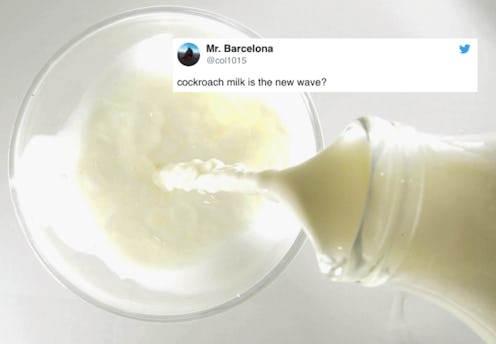
If you're an adventurous eater, you may be intrigued about a milk product that's being touted as the newest food trend: Cockroach milk. Unfortunately, it isn't just a clever name for a product — it's literally milk from cockroaches. The phenomenon isn't exactly new — it first went viral after a 2016 study explored the nutritious value of milk from a cockroach species. Even though cockroaches aren't mammals, Diploptera Punctata, a type of Pacific beetle cockroach, gives birth instead of laying eggs, and feeds its young with a liquid similar to human milk. As things on the Internet are wont to do, it inexplicably went viral again this past week. Even though we first mentally processed this two years ago, people are talking about cockroach milk and wondering whether it's the future. The answer is two-fold.
What is cockroach milk? It's a real thing, even though it sounds like an email hoax. The study from 2016, conducted by India’s Institute for Stem Cell Biology and Regenerative Medicine (IUCr), concluded that the crystals produced by cockroaches are nutritious and could be valuable for humans. But will you ever drink cockroach milk? It's unlikely, BuzzFeed News reports. If you're looking for a sustainable dairy alternative, you're much better off with another option. Even though seeing cockroach milk for sale would be quite the experience, it isn't realistic.
After the 2016 research went viral, the scientists behind the project hinted that the proteins in cockroach milk could end up being nutritious for humans. "The crystals are like a complete food – they have proteins, fats and sugars. If you look into the protein sequences, they have all the essential amino acids," said study author Sanchari Banerjee in an interview with The India Times. But even though the internet collectively laughed and cried at the idea of a cockroach milk factory, it's not going to happen.
First, cockroaches aren't cows or goats, and you can't harvest the milk while a cockroach is alive. Buzzfeed reports that researchers have to slice open pregnant cockroaches, take apart an embryo, and use a pipette to get to the liquid. And it's not just time-intensive — the number of cockroaches required to make enough of the substance to merit consuming it is seriously astounding. According to a report from Inverse, you would need to kill 1,000 cockroaches to get 100 grams of milk, which is roughly 3.5 ounces. That means a glass of milk would require more than 2,000 dead cockroaches. If we continue to scale up, that means a gallon of cockroach milk would require roughly 38,000 dead cockroaches. Though you may think cockroaches are an abundant resource, especially during the summer in New York City, the amount of labor required to extract the nutrients is extremely ineffective.
Compare that process to oat milk, a dairy substitute made from rolled oats and water that can be made at home and, according to one recipe site, only takes five minutes to make. The obvious bonus is that it doesn't involve cockroaches, and it's reportedly pretty tasty, in addition to being dairy-free and nutritious. The impact that large-scale cockroach harvesting could have on the environment isn't known, but HuffPo notes that the bugs release nitrogen after feedings, which can help forest health. And killing millions of cockroaches to make milk seems like a waste of resources when you think about the effort involved.
So fear not — no one is going to prank you with a frothy glass of cockroach milk anytime soon, and adventurous eaters will have to find something else to set their sights on. While the protein crystals produced by the cockroaches could prove useful for researchers, especially evolutionary scientists, it's not going to impact your diet. If you want to try something other than cow's milk, it's best to stick with the safe and boring options you're already aware of, like oat, soy, or almond milk.